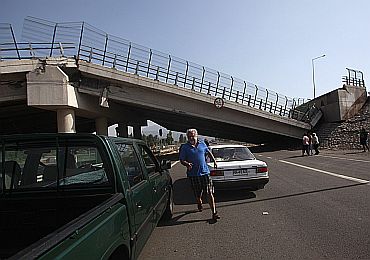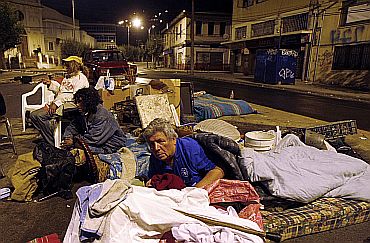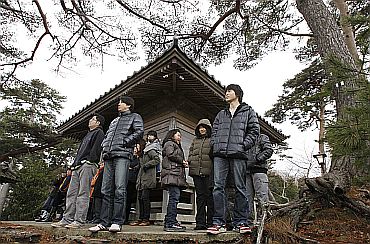 | « Back to article | Print this article |
Chilean disaster revives Japan's nightmare
Japan and Russia went on alert on Sunday, clearing tens of thousands of people out of vulnerable coastal areas as a tsunami triggered by Chile's massive killer quake powered across the Pacific.
Tsunami warnings were lifted in other nations across the Pacific Basin's 'Ring of Fire' as fears of destructive waves eased, but Tokyo and Moscow were taking no chances after one of the biggest earthquakes on record.
Waves pummeled Chile and rolled through into Hawaii, French Polynesia and the South Pacific as the tsunami moved at jet-speed across the vast ocean after Saturday's 8.8-magnitude quake, which left at least 300 people dead.
The Chilean disaster revived raw memories for Japan, where 140 lives were lost in 1960 when a 9.5-magnitude earthquake in the South American nation -- the largest on record -- sent a tsunami roaring across the Pacific.
Image: Motorists pass under a footbridge that has collapsed over the Panamerican Highway after a major earthquake in Curico, Chile
Photograph: Ivan Alvarado / Reuters
Click NEXT to read further..
Warning sirens wail across the 'Ring of Fire'
Five people were killed on the remote Robinson Crusoe archipelago far off the coast of Chile, the first reported tsunami casualties, but elsewhere no significant damage was reported and surges of water were smaller than expected.
The Hawaii-based Pacific Tsunami Warning Centre lifted its tsunami warning for everywhere except Japan and Russia, but the Philippines was also bracing for outsized waves. Japan warned that waves of up to three metres could hit its northern Pacific coastline, ordering more than 50,000 people living near the shore to leave and closing ports.
Warning sirens wailed as about 50 countries and territories along an arc stretching from New Zealand to Japan were put on alert, five years after the Indian Ocean tsunami disaster that killed more than 220,000 people.
Image: A boy stands amid the rubble of his home after a major earthquake hit Santiago
Photograph: Carlos Vera / Reuters
'Widespread damage'
"Last time, waves that hit after the first one became even more powerful," said Japan Meteorological Agency official Yasuo Sekita.
"We believe it will be the case this time, too," he said, as Japan Prime Minister Yukio Hatoyama set up an emergency task force.
Russia issued a similar warning and launched an evacuation in its Pacific peninsula of Kamchatka.
"We are expecting waves of up to two metres, which is a dangerous height, and so people are asked to evacuate from dangerous zones," Sakhalin island's tsunami centre chief, Tatyana Ivelskaya, said.
Thousands of families in the Philippines also fled coastal areas. "The most important thing is that for people not to panic. We have prepared all our local government units since last night," said Albay provincial official Joey Salceda.
The Hawaii centre, set up by Pacific governments after the 1960 tsunami, had warned of possible 'widespread damage' from waves as high as three metres. In Hawaii itself, the tsunami led to the evacuation of thousands of people and triggered panic buying of food, water and fuel. But there was little damage in the event.
Image: Residents sleeps in the streets for fear of aftershocks following a major earthquake in Valparaiso, Chile
Photograph: Eliseo Fernandez / Reuters
70,000 evacuated as tsunami reaches Japan
More than 70,000 people fled vulnerable coastal areas of Japan Sunday as a tsunami churned up by the huge earthquake in Chile slammed into the country's long Pacific coastline.
"Please do not approach the coast at any cost," Japanese Prime Minister Yukio Hatoyama said in nationally televised comments as Japan, one of the world's most quake-prone nations, went on its first major tsunami alert in 15 years.
The first tsunami wave, 30 centimetres high, hit Nemuro on the northern island of Hokkaido in the early afternoon, the Meteorological Agency said.
Far bigger waves of up to three metres could hit northern areas of Aomori, Iwate and Miyagi prefectures, south of Hokkaido, the agency said. Hatoyama urged extreme caution even as fears of destructive waves eased across the rest of the Pacific.
"We should not drop our guard," the prime minister said. "I would like people to take all possible measures."
The Meteorological Agency also issued warnings for waves of up to two metres along the entire Pacific coastline of the Japanese archipelago, from Hokkaido through to the southern island chain of Okinawa.
Tsunami warnings flashed across all television channels as authorities rushed at least 70,000 people living on Japan's east coast to schools and other public facilities located on higher ground.
Image: Japanese people watch Pacific coast as they evacuate during tsunami warning issued by the Japan Meteorological Agency at a shrine in Shichigahama, Miyagi Prefecture in northern Japan
Photograph: Toru Hanai / Reuters



